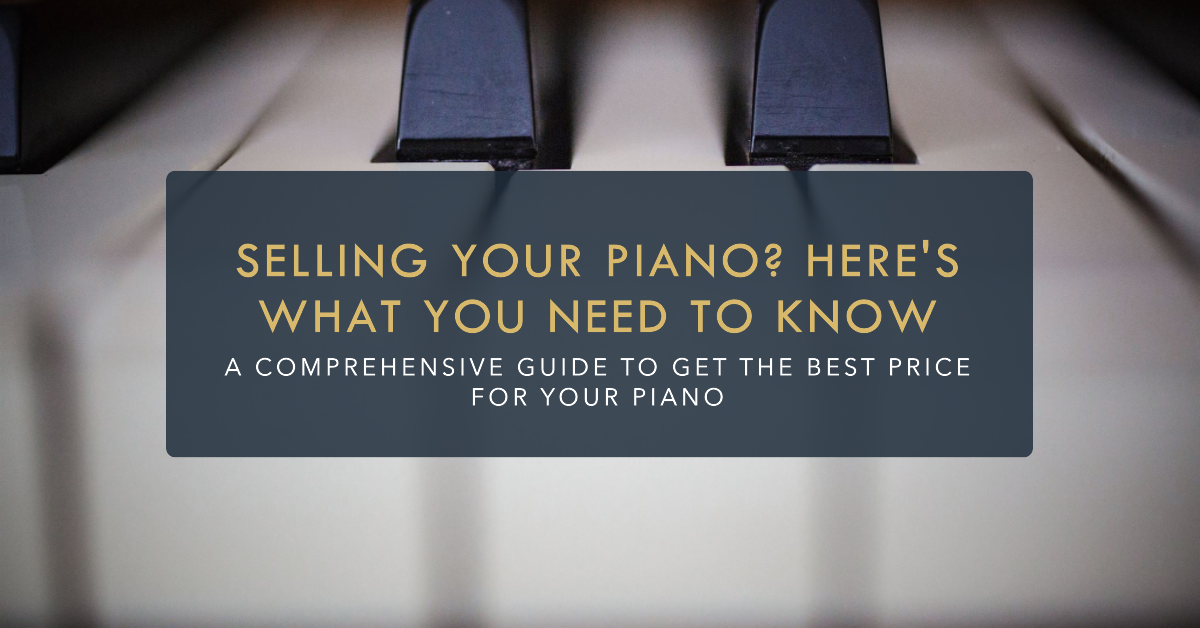Are you looking to sell your piano? Perhaps you have outgrown it or have moved into a smaller space. Whatever the reason, selling a piano can be a daunting task.
However, with proper preparation and marketing, you can ensure that you get the best price for your beloved instrument. Selling a piano is more than just placing an ad online and waiting for potential buyers to contact you.
It requires careful planning and execution to ensure that your piano stands out in the market. By following these tips, you can sell your piano with confidence and ease.
The Importance of Proper Preparation
Before putting your piano up for sale, it’s crucial to properly prepare it. This includes cleaning the instrument thoroughly both inside and out.
Dust buildup on strings and hammers can affect sound quality, so giving them a gentle cleaning with a soft cloth will go a long way. Additionally, tuning the instrument is essential before showcasing it to potential buyers.
An out-of-tune piano can be an instant turn-off for even the most interested buyer. Professional tuners are available for hire if needed.
Consider what features of the instrument make it unique or desirable to buyers. Is it particularly old or rare?
Does it have an ornate design or intricate details? These features should be highlighted when marketing the piano.
The Power of Marketing

Marketing is key when selling any item, including pianos. One way to start is by researching comparable sales data online or through music stores in your area. This will give you an idea of what other pianos are selling for in your region.
When advertising your piano online or in print ads, include as many details as possible about its condition and features. High-quality photos that show off both the outside and inside of the instrument are also important so that potential buyers can see all aspects of the piano.
Consider reaching out to local music teachers or schools to see if they have any students looking for a piano. These connections can be valuable when trying to reach potential buyers who may not be actively searching for pianos online.
Preparing the Piano for Sale
Cleanliness is Key

If you’re planning on selling your piano, it’s crucial that you take the time to clean it thoroughly. Giving your piano a good wipe-down will not only make it look its best, but it can also extend its lifespan. Dust and dirt buildup can cause damage to the keys, strings, and hammers over time. Read our comprehensive guide on Digital Piano Maintenance.
To properly clean your piano, use a soft cloth and gentle cleaning solution specifically designed for pianos. Avoid using harsh chemicals or abrasive materials that could scratch or damage the finish.
The Sound of Music
In addition to cleanliness, tuning is another important aspect of preparing your piano for sale. A well-tuned piano will showcase its sound quality and help attract potential buyers. If you’re not familiar with how to tune a piano yourself, consider hiring a professional tuner who can ensure that each key is in perfect pitch. Read our guide on How I Fixed the Tuning Issue on My Digital Piano.
Showcasing Your Piano’s Best Features
Once your piano is cleaned and tuned, it’s time to show off all of its best features! Take photos of the instrument from various angles and highlight any unique or special features that could appeal to potential buyers.
Be sure to include details such as the brand name, model number, age of the instrument, and any other relevant information in your listing or ad. When showcasing your piano’s sound quality, invite potential buyers to play the instrument themselves or provide recordings if possible.
This will allow them to fully experience how beautiful your piano sounds firsthand. By taking these steps before putting your piano up for sale you can ensure that it looks good as new and sounds even better!
Researching Market Value
The Importance of Proper Valuation
One of the most important steps in selling a piano is determining its market value. You don’t want to price it too high and turn off potential buyers, but you also don’t want to sell it for less than it’s worth. By doing your research, you can determine a fair asking price that will attract buyers and ensure a smooth sale.
How to Determine Your Piano’s Value
To determine your piano’s market value, start by researching comparable sales data. Look online at websites like eBay or Craigslist to see what similar pianos are selling for in your area.
Keep in mind that factors like age, condition, brand name, and model number can all affect the value of your piano. Another great resource is your local music store or piano dealer.
They can provide an estimate based on their knowledge of the local market and current trends. Additionally, there are professional appraisers who specialize in valuing musical instruments.
Resources for Finding Comparable Sales Data
There are several resources available for finding comparable sales data for pianos. One popular option is PianoNet.com, which offers free access to its database of recent piano sales across the US. The site allows you to search by brand name and model number and provides pricing information on both new and used pianos.
Another great resource is Blue Book of Pianos (bluebookofpianos.com), which offers a comprehensive guide to piano prices based on factors like age, condition, brand name, and model number. By taking these steps to properly evaluate your piano’s worth before putting it up for sale, you’ll be able to set a realistic asking price that resonates with potential buyers.
Marketing Your Piano
So, you’ve decided to sell your piano. Congratulations! Now comes the fun part: marketing it.
There are several ways you can go about this, and it’s important to choose the ones that will give you the most exposure. Here are some suggestions:
Online Classifieds
This is one of the easiest and most effective ways to market your piano. You can post an ad on websites like Craigslist or Facebook Marketplace for free, and reach a large audience of potential buyers in your area.
When writing your ad, make sure to include clear photos of the piano from different angles, as well as detailed information about its condition and features. Be honest about any flaws or damage so that buyers know exactly what they’re getting.
Social Media
Social media platforms like Facebook, Twitter, and Instagram can also be great places to market your piano. Share photos of your instrument with a brief description and price point on your personal page or in local buy/sell groups. You can also use relevant hashtags (#pianoforsale #musicgear #musicianswanted) to increase visibility among potential buyers who may be searching for those keywords.
Local Music Stores
If there are music stores in your area that specialize in selling instruments (especially pianos), consider reaching out to them directly about selling yours on consignment or through a trade-in program. These stores already have an established customer base of musicians who may be in the market for a used piano, so your chances of making a sale could be higher than if you were just advertising online.
Writing an Effective Ad
The key to writing an effective ad is highlighting the unique features and benefits of your piano while still being honest about any flaws or damage. Make sure to include the make and model of the piano, as well as its age, condition, and any upgrades or modifications that have been made. If your piano has a unique history or provenance (e.g. it belonged to a famous musician), be sure to mention that as well.
When writing your ad, try to put yourself in the shoes of potential buyers. What information would you want to know if you were considering purchasing a used piano?
Think about things like the instrument’s sound quality, responsiveness, and playability, as well as its size and weight (which could be important factors for buyers who are short on space or need to move the piano frequently). By marketing your piano effectively and writing an engaging ad that emphasizes its strengths while being upfront about any weaknesses, you’ll increase your chances of finding a buyer quickly and easily.
Walking the Tightrope: Negotiating with Potential Buyers
Selling a piano can be an emotional and stressful experience, especially if you’re dealing with difficult buyers or lowball offers. When it comes to negotiating, it’s important to set boundaries and have a clear idea of what you’re willing to accept. Here are some strategies for navigating the negotiation process:
1. Know Your Bottom Line: Before entering into negotiations, determine the lowest price you’re willing to accept for your piano.
This will help you stay grounded and avoid accepting offers that are too low. Consider the condition, age, brand and market value of your instrument before setting your bottom line.
2. Stay Calm and Confident: If a buyer is trying to lowball you or make unreasonable demands, remain calm and confident in your position.
Don’t let emotions cloud your judgment or push you into accepting a bad deal. 3.
Be Flexible: While having a bottom line is important, it’s also crucial to be flexible when it comes to negotiating terms like payment options or pickup/delivery schedules. Being accommodating can help build goodwill with potential buyers while still allowing you to maintain control of the transaction. Title: Lowball Offers & Difficult Buyers: How to Handle Them?
Negotiating with difficult buyers can be frustrating—but don’t let them take advantage of you! Here are some tips for handling challenging situations: 1.
Respond Firmly but Politely: If someone makes an offer that is far below your asking price or tries to negotiate unreasonably, respond firmly but politely that this offer doesn’t meet your expectations or what has already been agreed upon. 2.
Educate Buyers on Value: Oftentimes, buyers may not understand why pianos hold their value so well over time – especially if they’re used to purchasing items that depreciate quickly. Take the time to explain why your piano commands a certain price and what makes it a valuable investment.
3. Know When to Walk Away: It’s important to know when to walk away from a deal if you’re not getting what you deserve for your instrument.
Don’t let yourself be backed into a corner by unreasonable demands or lowball offers – sometimes, it’s better to hold out for the right buyer and the right price. Whether you’re dealing with difficult buyers or lowball offers, always remember that negotiation is a two-way street.
Approach each situation with confidence and flexibility, and don’t be afraid to walk away if necessary. With some patience and persistence, you can find the perfect buyer for your piano at the right price.
Closing the Sale
Arranging Pickup or Delivery
Once you have found a buyer for your piano, it’s important to arrange for pickup or delivery. If the buyer lives nearby, you may be able to arrange for them to come and pick up the piano themselves. However, if the buyer is located further away, you will need to consider shipping options.
Be sure to research various shipping companies and compare prices before making a decision. Additionally, make sure that the piano is properly packaged and protected during shipping to prevent damage.
Transferring Ownership Documents
Before finalizing the sale of your piano, it’s important to transfer ownership documents to ensure that both parties are protected. This can include bills of sale, registration papers, warranties or any other relevant documentation. Be sure that all paperwork is properly filled out and signed by both parties before exchanging money or releasing the piano.
Tips on Ensuring a Smooth Transaction
To ensure a smooth transaction when selling your piano, communication with the buyer is key. Keep in touch with them throughout the process and answer any questions they may have in a timely manner. Be sure to discuss payment options ahead of time so there are no surprises later on.
Additionally, be prepared for any last-minute negotiations that may arise. Always be honest and transparent about any flaws or issues with the piano in order to build trust with potential buyers.
Overall, closing a sale successfully requires attention to detail and proper communication between both parties involved. By following these steps carefully and being prepared for anything along the way, you can ensure a positive experience when selling your beloved instrument.
Conclusion
Selling a piano can be an overwhelming process, but with proper preparation and marketing, it can also be a successful one. By following the steps outlined in this article, you can ensure that you get the most out of your piano sale. First and foremost, preparing the piano for sale is essential.
Cleaning and tuning your instrument will not only make it more appealing to buyers but will also showcase its full potential. Researching market value is also crucial; by finding comparable sales data and setting a fair asking price, you can attract serious buyers.
Marketing your piano is another crucial step in selling your instrument. Utilizing online classifieds, social media platforms or local music stores can help get your ad in front of a larger audience.
Writing an effective ad that highlights key features and benefits will help set your piano apart from others on the market. Negotiating with potential buyers may be intimidating at first, however by setting boundaries and knowing when to walk away from a deal, you can ensure that you get a fair price for your instrument.
Once you have found a buyer it’s time to close the sale! Arranging pick-up or delivery of your instrument while transferring ownership documents are just some of the critical steps needed to complete this process smoothly.
Selling a piano takes patience and attention to detail. By taking these steps seriously and remaining optimistic throughout the process, there’s no reason why selling your beloved instrument cannot be an enjoyable experience that ends with both parties feeling happy with their transaction.





